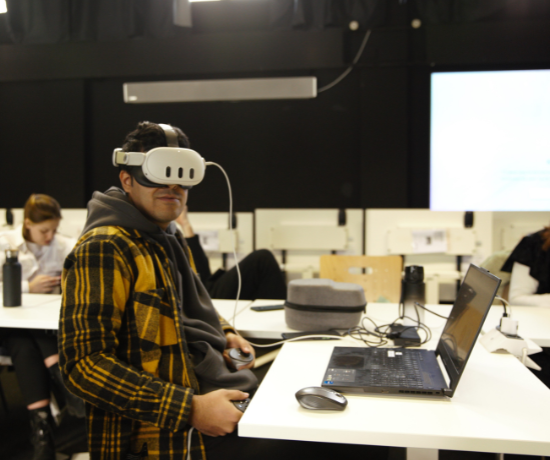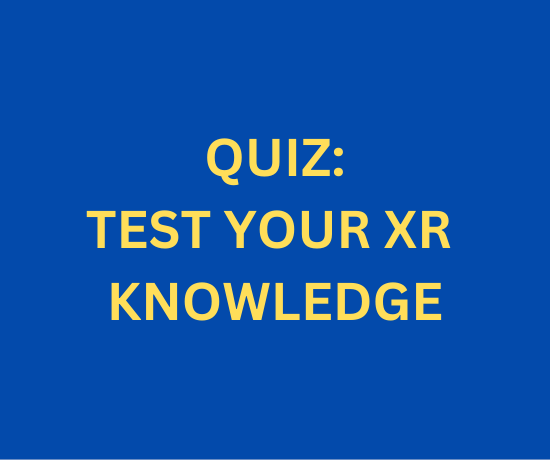Assess your knowledge of Extended Reality (XR) through this carefully crafted quiz. Covering beginner to intermediate levels, it highlights important concepts and practical applications. Dive in and see how much you know!
Instructions :
⮚ Answer all the questions to test your knowledge about various aspects involved in XR.
⮚ Choose the most appropriate/best answer for each question
Section 1: Fundamentals of XR (Extended Reality)
- What does XR stand for?
a) Extra Reality
b) Extended Reality
c) Experimental Reality
d) Enhanced Reality
Correct Answer = b) Extended Reality - Which of the following is NOT a component of XR?
a) Virtual Reality (VR)
b) Augmented Reality (AR)
c) Mixed Reality (MR)
d) Quantum Reality (QR)
Correct Answer = d) Quantum Reality (QR) - Who is considered the pioneer of the first virtual reality head-mounted display?
a) Steve Jobs
b) Ivan Sutherland
c) Mark Zuckerberg
d) Alan Turing
Correct Answer = b) Ivan Sutherland - True or False: VR completely replaces the real-world environment, whereas AR enhances the real
world with digital overlays.
Correct Answer = True - Which of the following is NOT a term associated with XR?
a) Virtual Reality (VR)
b) Augmented Reality (AR)
c) Parallel Reality (PR)
d) Mixed Reality (MR)
Correct Answer = c) Parallel Reality (PR)
Section 2: Characteristics and Technologies
- Which of the following is NOT a defining characteristic of Virtual Reality?
a) Immersion
b) Presence
c) Sensory Deprivation
d) Interaction
Correct Answer = c) Sensory Deprivation - What is the main difference between Augmented Reality (AR) and Augmented Virtuality (AV)?
a) AR adds virtual elements to the real world, whereas AV adds real elements to a virtual world.
b) AV adds virtual elements to the real world, whereas AR adds real elements to a virtual world.
c) Both AR and AV fully replace the real world.
d) AV is another term for Mixed Reality.
Correct Answer = a) AR adds virtual elements to the real world, whereas AV adds real elements to a
virtual world. - Which of the following industries is NOT a common use case for XR?
a) Healthcare
b) Education
c) Space Travel
d) Military
Correct Answer = c) Space Travel - True or False: The Reality-Virtuality Continuum describes the spectrum between the real
environment and a fully virtual environment.
Correct Answer = True - Which hardware is commonly required for VR experiences?
a) Head-mounted display (HMD)
b) Keyboard and mouse only
c) Traditional television screen
d) Projector screen
Correct Answer = a) Head-mounted display (HMD)
Section 3: Applications of XR
- Which of the following is NOT an emerging application of XR?
a) Courtroom crime scene reconstruction
b) Virtual real estate tours
c) Space-Time Manipulation
d) Virtual sports coaching
Correct Answer = c) Space-Time Manipulation - How is XR transforming language learning?
a) By providing immersive environments for real-world communication
b) By making translation obsolete
c) By replacing traditional classrooms entirely
d) By reducing the need for teachers
Correct Answer = a) By providing immersive environments for real-world communication - Which of the following is a benefit of using XR in the military?
a) Costly real-world simulations
b) Realistic training with minimal risk
c) Increased physical injuries during training
d) Less awareness and preparedness for real-world situations
Correct Answer = b) Realistic training with minimal risk - Which field has benefited the most from XR medical simulations?
a) Surgery
b) Retail management
c) Music Production
d) Urban planning
Correct Answer = a) Surgery - What type of XR application is commonly used for remote collaboration?
a) AR-based teleconferencing
b) Traditional video calls
c) Non-interactive email communication
d) Basic text messaging
Correct Answer = a) AR-based teleconferencing
Section 4: Challenges & Future of XR - Which of the following is a common challenge in XR development?
a) Unlimited hardware performance
b) Lack of content standardization
c) Low costs and easy mass adoption
d) XR eliminating the need for human interaction
Correct Answer = b) Lack of content standardization| - True or False: XR will likely become a seamless part of daily life in the future with
hyper-realistic experiences and deeper integration into education and healthcare.
Correct Answer = True - Which factor is crucial for making XR more accessible to the general public?
a) Increasing the cost of XR devices
b) Improving XR software and reducing costs
c) Removing AI integration from XR
d) Limiting XR to only gaming applications
Correct Answer = b) Improving XR software and reducing costs - What is a potential concern regarding privacy and security in XR environments?
a) Unauthorized tracking of user behaviour
b) Improved personalization of ads
c) Enhanced social connectivity
d) Stronger data encryption
Correct Answer = a) Unauthorized tracking of user behaviour - How is XR expected to evolve over the next 10 years?
a) Greater integration with AI and real-world applications
b) Decline in XR adoption due to high costs
c) XR remaining solely within the gaming industry
d) No significant advancements beyond current technologies
Correct Answer/ Most suitable answer according to market trends = a) Greater
integration with AI and real-world applications
Scoring Guide
- 0-5 correct answers: Beginner – You have some understanding of XR, but there is space for
improvement! Look into XR applications and technology further. - 6-10 correct answers: Intermediate – You have a solid understanding of XR ideas. Keep up with
developing trends to broaden your knowledge. - 11-15 correct answers: Advanced – Great work! You grasp the fundamentals and technical features
of XR. Keep up with current developments. - 16-20 correct answers: Expert – Fantastic! You have a solid understanding of XR ideas,
applications, and issues. You are quite knowledgeable in this ever-changing area!





No Comments